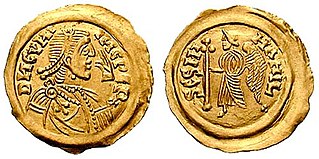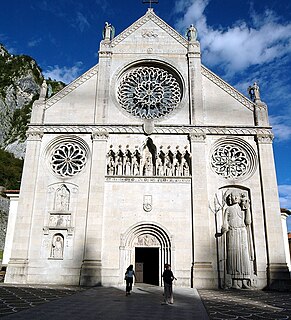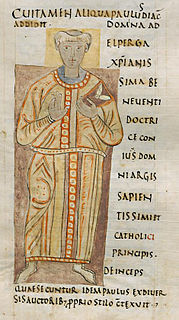This page is based on this
Wikipedia article Text is available under the
CC BY-SA 4.0 license; additional terms may apply.
Images, videos and audio are available under their respective licenses.

Quo Vadis: A Narrative of the Time of Nero, commonly known as Quo Vadis, is a historical novel written by Henryk Sienkiewicz in Polish. "Quo vadis, Domine?" is Latin for "Where are you going, Lord?" and appears in Chapter 69 of the novel in a retelling of a story from the apocryphal Acts of Peter, in which Peter flees Rome but on his way meets Jesus and asks him why he is going to Rome. Jesus says, "If thou desertest my people, I am going to Rome to be crucified a second time", which shames Peter into going back to Rome to accept martyrdom.

Cunincpert was king of the Lombards from 688 to 700. He succeeded his father Perctarit, though he was associated with the throne from 680.

The Patriarchate of Aquileia was an episcopal see in northeastern Italy, centred on the ancient city of Aquileia situated at the head of the Adriatic, on what is now the Italian seacoast. For many centuries it played an important part in history, particularly in that of the Holy See and northern Italy, and a number of church councils were held there.
Grimoald II was the duke of Benevento from 687 to his death. He was the son and successor of Romuald I of Benevento. He was possibly under the regency of his mother, Theodrada, daughter of Lupus of Friuli. His reign of three years was uneventful: Paul the Deacon records nothing but his marriage and death. He is said to have been an opponent of the crown. He was succeeded by his brother Gisulf. He was married to Wigilinda, daughter of King Perctarit.
Gisulf I was the duke of Benevento from 689, when his brother Grimoald II died. His father was Romuald I. His mother was Theodrada, daughter of Lupus of Friuli, and she exercised the regency for him for the first years of his reign.
Gisulf II was the Duke of Friuli from around 591 to his death. He was the son and successor of Gisulf I.
Tasso was the joint Duke of Friuli with his younger brother Kakko from their father's death (611) to their own. Their father was Gisulf II. In or around 611, Gisulf was killed fending off an Avar invasion.
Grasulf II, son of Duke Gisulf I, was the Duke of Friuli after the assassination of his nephews, Tasso and Kakko, in Oderzo in 616 or 617. His other nephews, Radoald and Grimoald, left Friuli for the Duchy of Benevento because they did not wish to live under Grasulf. Nothing more is known about Grasulf and the date of his death is uncertain. He died at Cividale.
Pemmo was the Duke of Friuli for twenty-six years, from about 705 to his death. He was the son of Billo of Belluno.

Gisulf I was probably the first duke of Friuli. He was a nephew of Alboin, first king of the Lombards in Italy, who appointed him duke around 569 after the Lombard conquest of the region, though some scholars believe he appointed his brother Grasulf I, Gisulf's father.

Gemona del Friuli is a comune (municipality) in the Province of Udine in the Italian region Friuli-Venezia Giulia, located about 90 kilometres (56 mi) northwest of Trieste and about 25 kilometres (16 mi) northwest of Udine.
Eric was the Duke of Friuli from 789 to his death. He was the eldest son of Gerold of Vinzgouw and by the marriage of his sister Hildegard the brother-in-law of Charlemagne.
Lupus was the Duke of Friuli from between 660 and 663 to his death around 666.
Arnefrit, Arnefrid, Amefrit, or Amefrith was the son of Lupus of Friuli who claimed the Duchy of Friuli after his father's death in 666.
Ansfrid, Ansfrit, or Ausfrid was the Duke of Friuli in 694. He was originally the lord of the castle of Ragogna.
Ado was the Duke of Friuli after the usurper Ausfrid was defeated at Verona in 694. According to Paul the Deacon, he was a brother of the former duke Rodoald and ruled for a year and seven months. The actual length of his reign is disputed, as is the year of its occurrence. He appears with the title loci servator (caretaker) and may have only held the duchy as regent on behalf of the king.
Gaidoald was the second Lombard Duke of Trent. He was assigned to Trent on the death of Euin in January 595. He was described by Paul the Deacon as "a good man and a Catholic in religion" in his Historia Langobardorum. In 602 or 603, Gaidoald and fellow duke Gisulf I of Friuli made peace with king Agilulf in what Paul the Deacon refers to as a "year of peace". No dukes of Trent are known after Gaidoald until Alahis from 680 to 690.
Austria was, according to the early medieval geographical classification, the eastern portion of Langobardia Major, the north-central part of the Lombard Kingdom, extended from the Adda to Friuli and opposite to Neustria. The partition had not only been territorial, but also implied significant cultural and political differences.






